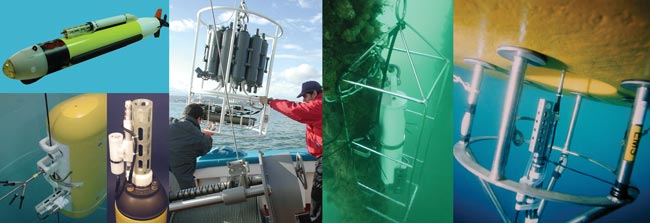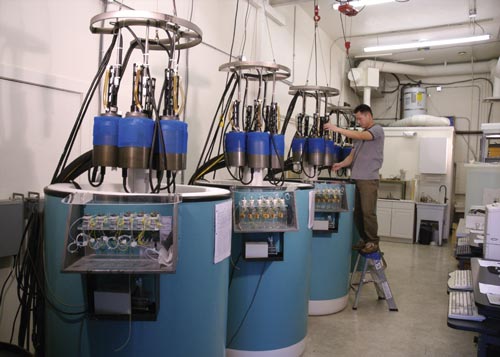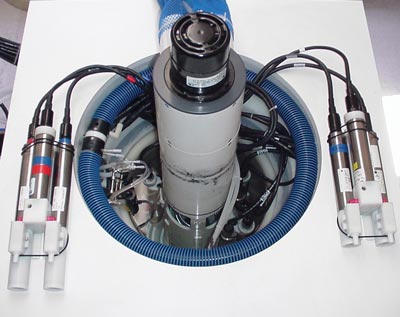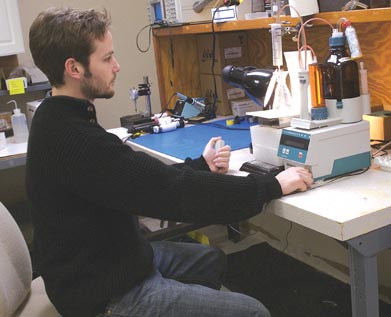| As seen in | Volume 14, Issue 2, March 2008: |

Sea-Bird Electronics, Inc.
![]()
Link to technical papers Subscribe to Ocean News & Technology

Sea-Bird Electronics, Inc. is the leading manufacturer of oceanographic CTDs and integrated water sampling systems. CTDs measure conductivity, temperature, and pressure (depth), as well as dissolved oxygen and other variables, enabling oceanographers to determine salinity, density, and other properties contributing to ocean circulation, the function of marine ecosystems, and global climate dynamics. Sea-Bird has been serving customers in universities, oceanographic institutes, government agencies, engineering firms, and navies throughout the world for over 30 years, and has built a reputation for producing the most accurate data possible.
The owners and top management of the company have extensive oceanographic and sea-going experience and are dedicated to advancing the science of ocean measurement and developing new capabilities that contribute to better understanding of the oceans. Sea-Bird employs over 90 people, including 5 oceanographers, and has more than 40 products in current production to meet growing measurement challenges encountered as oceanographic research and monitoring applications employ more diverse instrument platforms. Research vessels, fixed moorings, moored profilers, autonomous drifting profilers (Argo floats), surface salinity floats, AUVs, autonomous gliders, and large-scale networked sensor arrays in ocean observatories all present different and complex challenges in acquiring high-accuracy salinity and oxygen data.
While temperature can be measured relatively accurately on many different platforms using the same sensor, salinity cannot. Salinity is calculated from the measurements of temperature, electrical conductivity, and pressure of seawater. The salinity equation depends on precisely defined relationships between these parameters, particularly temperature and conductivity. Large errors in salinity result from small errors in these measurements caused by calibration uncertainty, and by spatial and temporal mismatch induced by instrument platform dynamics, local oceanography, and fouling attack. These errors often greatly diminish the instrument’s achievable accuracy that would otherwise be implied by its initial “calibration” accuracy.
Sea-Bird focuses on delivering the most accurate calibrations possible, designing instruments that eliminate or minimize dynamic errors, and preserving initial accuracy throughout a deployment. It offers a wide variety of platform-specific instruments engineered to produce the most accurate data possible. Accuracy begins with stable sensors and circuits, and calibration in Sea-Bird’s state-of-the-art automated bath systems for temperature, conductivity, and dissolved oxygen. The calibration facilities are backed by an in-house metrology laboratory where primary standards in temperature (water triple point and gallium melting point) and conductivity (IAPSO Standard Seawater) are maintained. Calibration bath data, reference sensor stability, and standards data are monitored daily and regularly reviewed for consistency by the chief scientist.

Calibration
Bath Facilities
The economies of scale and efficiencies of automation also benefit customers by keeping calibration costs low, and by providing “new production” and “customer service” calibration capacity to keep pace with new instrument sales and support of the growing world-wide fleet of deployed instruments projected for the future. In 2007, these automated calibration systems performed a combined total of more than 35,000 complete sensor calibrations.
|
|
Since 2000, Sea-Bird has also developed cutting-edge calibration capability in dissolved oxygen. Using Winkler titration standards, every Sea-Bird dissolved oxygen sensor is calibrated in a temperature-controlled bath at 3 oxygen concentrations with 6 temperature points at each concentration (18 points).
 Three automated oxygen sensor calibration systems, as pictured above, deliver speed, accuracy, precision, and low calibration cost. |
 Over 2000 Winkler titrations performed annually support oxygen sensor calibrations and single-point verifications. |
Even the most accurate calibration does not guarantee that a CTD will produce accurate data. Whether profiling vertically from a heaving vessel or sampling on an underway AUV or undulating towed vehicle, dynamically changing conditions inherent in a given platform will impart errors to the individual measurements of temperature, conductivity, and pressure. As the CTD encounters gradients in ocean temperature and salinity, it must maintain its ability to respond quickly and accurately and maintain proper phasing between discrete samples occurring at different times and points along the CTD’s trajectory.
Varying descent rates due to ship heave and changing vehicle attitudes present constantly changing flow conditions to the CTD sensors, the response times of which are flow dependent to varying degrees. A change in flow rate changes response time, in turn creating mismatched responses and producing erroneous salinity calculations. Dynamic oceanographic conditions combine with motion-induced response changes to produce measurement errors 10 to 100 times larger than initial (small) calibration errors typically quoted as accuracy specifications.
Moorings are also dynamic environments. Even though platform motions are smaller in magnitude and rate, ocean currents and waves move temperature and density surfaces past sensors at rapid rates, and moored sensors suffer prolonged attack by fouling which causes drift in calibration and flow conditions around the sensor that can change unpredictably. Marine growth often creates a microenvironment at the point of measurement that is different from the true ocean environment. For example, respiring organisms very near a dissolved oxygen sensor consume oxygen, creating a lower-than-ambient oxygen concentration.
Sea-Bird profiling CTDs share key features that minimize dynamic error sources. The basic design concept creates an enclosed flow path (think of this as a pipe) within which the critical sensors (T, C, & DO) are located. Pumping water through the pipe forces all the measurements to be made on the same sample of water with a predictable delay and predictable flow effects.
|
|
By pumping at a constant rate, response times of T and C sensors can be engineered to match and remain independent of the CTD's speed through the water. This dramatically reduces salinity spiking errors produced when sensors with different response times encounter a gradient. Also, the transit time of water through the pipe is fixed, permitting lag times between measurements made at different locations in the pipe to be a known constant, so that aligning and coordinating measurements relative to pressure can be accomplished automatically in hardware or with processing software.
Moored CTDs, like the 37-SMP MicroCAT, are also designed to make measurements in a pipe, but for different reasons. Active pumping delivers a completely new sample of water to the conductivity and oxygen sensors, independent of ambient circulation. An inverted U-shaped flow path provides passive flow control and nulls cell flushing provoked by waves, currents, or mooring motion. Between measurements, water is trapped in the cell and anti-foulant concentration accumulates to effective levels by diffusion, thus preserving the initial calibration accuracy for very long deployments.

SBE 37-SMP MicroCAT.
Some applications require both high dynamic accuracy and long-term prevention of fouling. The SBE 41 Argo CTD is a profiling CTD developed for expendable autonomous drifting floats (Argo floats). Spending most of their nominal 5-year deployment life drifting at 1,000 to 2,000 meters deep, they surface every 10 days to collect a CTD profile on the way up and send data home by satellite.
|
|
|
The SBE 41 design features include T-C ducted sensors and pumped flow for dynamic accuracy during sampling, and passive flow control and anti-fouling features that work between profiles to prevent fouling. Sea-Bird’s strategies for delivering dynamic accuracy and preserving it for multi-year deployments are proven on over 5000 Argo float CTDs manufactured since 1997. Demonstrated salinity stability after 5 years in the ocean has been better than 5 parts per million (0.005 PSU).
Sea-Bird strives to create a consultative and collaborative relationship with its customers. By gaining an understanding of their data requirements, and the deployment conditions that will affect their intended measurements, Sea-Bird can offer its oceanographic expertise as well as instrument knowledge and experience, in helping them make instrument choices that bring best value to their research or monitoring programs.
![]()
Sea-Bird Home Phone: (+1) 425-643-9866 E-mail: seabird@seabird.com